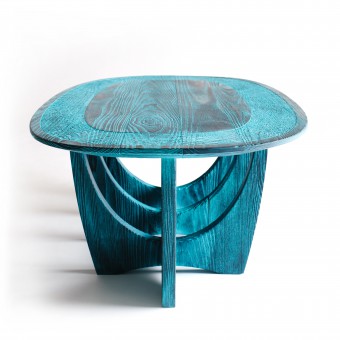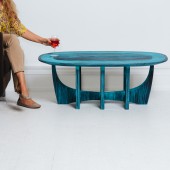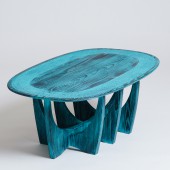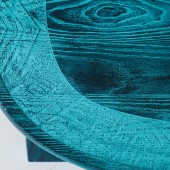Herculano Coffee Table by Steve Visser |
Home > Winners > #58604 |
 |
|
||||
| DESIGN DETAILS | |||||
| DESIGN NAME: Herculano PRIMARY FUNCTION: Coffee Table INSPIRATION: Herculano was inspired by ancient furniture and a wooden boat from Herculaneum Italy, which was preserved by the eruption of Mt. Vesuvius in 79AD. The furniture was carbonized by the hot mud that buried the city. Herculano has been flame charred and then pigmented to highlight the woods natural grain and the checking caused by the fire. The top also has an oval stripe that has been etched into the wood with a laser that makes the textural imprint into the surface. UNIQUE PROPERTIES / PROJECT DESCRIPTION: Herculano is supported by an interlocking leg structure. The legs create an implied shape of an ancient Roman vessel. The delicate legs, are made of resilient wood from Ash trees, which have been harvested due to the Ash bore infestation that has been ravishing local forests. Using this surplus wood for high quality furniture will preserve it for years to come. OPERATION / FLOW / INTERACTION: The Herculano coffee table is made of five parts, a long leg that is reminiscent of a boats keel and three cross legs that are like the ribs of a boat. The legs have notches that allow them to interlink. The tabletop has mortis pockets (small square holes) that the legs insert into as tenons. Once the legs are interlinked and inserted into the mortises the structure is locked together with a pin. To collapse the table simple remove the pin and disassemble. PROJECT DURATION AND LOCATION: The inspiration for the project began at museums and archeological sites in Rome, Milan, Naples, and Herculaneum. The design was created in 2015-2016 in West Lafayette IN, USA, production commenced in 2017, West Lafayette, IN, USA. FITS BEST INTO CATEGORY: Furniture Design |
PRODUCTION / REALIZATION TECHNOLOGY: The top is 30mm thick with a strong relief underneath to create the look of a thin top, yet with the strength of the thick top. The oval pattern in the top is created by laser etching a photograph of tire treads into the wood. The assembled table is then flamed with a propane torch to char the surface. It is then wire brushed to remove the damaged portions of the wood. Finally, the wood is pickled with a vibrant blue pigment to accentuate the wood grain and the checking caused by the charring process. SPECIFICATIONS / TECHNICAL PROPERTIES: Herculano is made of solid ash. The legs are made of three layers of ash, laminated together. The inner layer has the grain running horizontal, while the outside layers have the grain running vertical. This change in direction of the grain provides strength and the visual look that is consistent. The dimensions are 1120 X 690 X 424mm. The interlocking legs ship flat for delivery. TAGS: Furniture, charred, wood, Roman inspiration, RESEARCH ABSTRACT: The Herculano coffee table is one of many designs that were inspired from research done at the American Academy in Rome. Specifically, study of carbonized furniture from first century Herculaneum. Special thanks to: the American Academy in Rome for providing the creative environment unlike any other I have experienced, SAI and Domus Academy in Milan, Purdue University, the National Archaeological Museum in Naples for providing access to the archives, and the Archeological Site at Herculaneum for access to the conservation room. CHALLENGE: The early mockups of the table design relied on traditional legs that extended downward from the tabletop to the ground. During critique of these early mockups, a colleague suggested inverting the leg structures. Eventually, multiple inverted legs were combined, which created the hull shape within the legs. ADDED DATE: 2017-06-29 01:34:36 TEAM MEMBERS (4) : Design by Steve Visser, Manufacturing by Purdue Carpentry , Laser etching by David Marchese and IMAGE CREDITS: Image #1: Photographer Brian Powell, Glamor View, 2017. Image #2: Photographer Brian Powell, Front View, 2017. Image #3 Photographer Brian Powell, Herculano in Use, 2017. Image #4 Photographer Brian Powel, High View, 2017. Image #5 Photographer Brian Powell, Herculano Top Detail, 2017 PATENTS/COPYRIGHTS: Copyright Steve Visser, 2017 |
||||
| Visit the following page to learn more: http://www.stevevisser.design | |||||
| AWARD DETAILS | |
 |
Herculano Coffee Table by Steve Visser is Winner in Furniture Design Category, 2017 - 2018.· Read the interview with designer Steve Visser for design Herculano here.· Press Members: Login or Register to request an exclusive interview with Steve Visser. · Click here to register inorder to view the profile and other works by Steve Visser. |
| SOCIAL |
| + Add to Likes / Favorites | Send to My Email | Comment | Testimonials | View Press-Release | Press Kit | Translations |
Did you like Steve Visser's Furniture Design?
You will most likely enjoy other award winning furniture design as well.
Click here to view more Award Winning Furniture Design.








